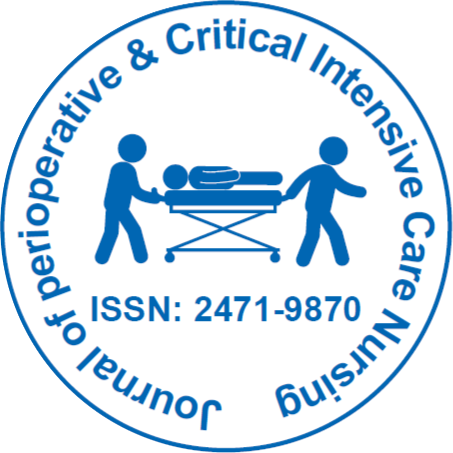
Journal of Perioperative & Critical Intensive Care Nursing
Open Access
ISSN: 2471-9870
+44-77-2385-9429

ISSN: 2471-9870
+44-77-2385-9429
Perspective - (2024)Volume 10, Issue 2
Pain management is a critical component of healthcare, aiming not only to alleviate suffering but also to optimize patient outcomes and quality of life. This article discusses the multifaceted aspects of pain management, from its importance in healthcare settings to current strategies and advancements in the field. Pain is a complex sensory and emotional experience, influenced by biological, psychological, and social factors. It serves as a vital indicator of underlying health conditions and plays a significant role in patient well-being and recovery. Effective pain management is need to mitigate distress, facilitate healing, and improve overall patient satisfaction and compliance with treatment regimens.
Challenges in pain management
Despite significant advances in pain management,several challenges persist that affect the efficacy of treatment and patient outcomes:
Under treatment: Misconceptions about pain tolerance and concerns about opioid misuse can lead to inadequate pain relief.
Opioid epidemic: Balancing the need for effective pain relief with the risks of opioid dependence and addiction remains a significant challenge.
Variability in pain perception: Variations in pain perception among individuals necessitate personalized approaches to pain management.
Access to care: Disparities in access to pain management resources and specialists can impact treatment outcomes.
Strategies in pain management
Strategies in pain management includes:
Multimodal approaches: Combining pharmacological (e.g., non-opioid analgesics, opioids when necessary), non-pharmacological (e.g., physical therapy, acupuncture), and psychological interventions (e.g., cognitive-behavioral therapy) for comprehensive pain relief.
Patient-centered care: Involving patients in treatment decisions, setting realistic goals, and addressing concerns about pain management.
Early intervention: Addressing pain promptly can prevent chronic pain development and improve recovery outcomes.
Education and training: Continuous education for healthcare providers on pain assessment, management guidelines, and new treatment modalities.
Palliative care and hospice services: Providing compassionate care for patients with advanced illnesses, focusing on pain relief and quality of life.
Patient-centred care and ethical considerations
Patient-centred care and ethical considerations includes the below conditions.
Comprehensive assessment: Regular evaluation of pain intensity, location, and impact on daily activities to tailor treatment strategies accordingly.
Shared decision-making: Involving patients in treatment planning, discussing benefits, risks, and alternatives to empower informed choices.
Ethical guidelines: Ensuring equitable access to pain relief while addressing concerns about opioid misuse, dependence, and societal stigma..
Quality of life: Focusing on improving functional outcomes, reducing disability, and enhancing emotional well-being through compassionate, holistic care.
Advancements in pain management
Targeted drug delivery systems implantable devices for delivering medication directly to the spinal cord or peripheral nerves. Neuromodulator techniques transcutaneous electrical nerve stimulation, spinal cord stimulation, and deep brain stimulation for chronic pain conditions. Precision medicine tailoring treatment based on genetic, pharmacogenomics, and biomarker profiles to optimize pain relief and minimize side effects.
Future directions
Alternative therapies showing the efficacy of cannabis-based products, mindfulness-based therapies, and virtual reality in pain management. Telemedicine remote consultations and monitoring for chronic pain management, enhancing accessibility and continuity of care. Biofeedback and wearable devices utilizing biofeedback mechanisms and wearable technologies to monitor pain levels and customize treatment plans. Furthermore, advancements in telemedicine facilitate remote consultations and monitoring, particularly beneficial for chronic pain management, enhancing accessibility and continuity of care. Biofeedback techniques and wearable devices provide real-time data on pain levels, enabling healthcare providers to customized treatment plans dynamically. Embracing these technologies and therapies underscores a shift towards more patient-centered and innovative approaches in pain management, aiming to improve overall quality of life for individuals managing chronic pain.
Effective pain management is need for improving patient outcomes, enhancing quality of life, and reducing healthcare costs associated with uncontrolled pain. By addressing challenges, implementing evidence-based strategies, and embracing technological advancements, healthcare providers can continue to advance pain management practices and meet the diverse needs of patients. By integrating these efforts into clinical practice, healthcare providers can establish a comprehensive framework for effective pain management, ensuring that patients receive the best possible care customizedto their individual needs.
Citation: Gao H (2024) Role of Pain Management in Patient Care: Approaches to Pain Relief in Modern Healthcare. J Perioper Crit Intensive Care Nurs. 10:250.
Received: 14-May-2024, Manuscript No. JPCIC-24-32828; Editor assigned: 16-May-2024, Pre QC No. JPCIC-24-32828 (PQ); Reviewed: 30-May-2024, QC No. JPCIC-24-32828; Revised: 06-Jun-2024, Manuscript No. JPCIC-24-32828 (R); Published: 13-Jun-2024 , DOI: 10.35248/2471-9870. 24.10.250
Copyright: © 2024 Gao H. This is an open-access article distributed under the terms of the Creative Commons Attribution License, which permits unrestricted use, distribution, and reproduction in any medium, provided the original author and source are credited.